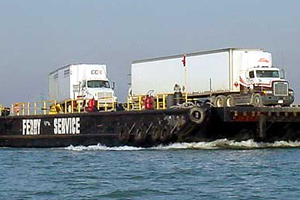Michigan DOT Recommends Lifting Hazmat Ban on Ambassador Bridge

A study by the Michigan Department of Transportation has recommended lifting the ban against trucking some hazardous materials across the Ambassador Bridge, the busiest crossing along the U.S.-Canada border.
MDOT is taking public comment on its study until May 27 but still has a year’s worth of work to do before it makes a final decision on hazmat restrictions for the 83-year-old span, said MDOT spokesman Jeff Cranson.
Click here to view the MDOT study (8-pp. PDF), or e-mail comments to MDOT’s Robert Parsons: parsonsb@michigan.gov
Currently, explosives, radioactive material, flammable liquids and corrosive material are banned from the bridge and must be transported by truck ferry across the Detroit River or by truck via the Blue Water Bridge, which connects Port Huron, Mich., and Point Edward, Ontario.
That bridge, however, is 60 miles north of Detroit, while the Ambassador Bridge connects Detroit directly to Windsor, Ontario.
The state began reviewing the ban after its owners, the family of billionaire Manuel Moroun, filed a request that it be lifted.
A top executive of the National Tank Truck Carriers said there’s no safety reason why hazardous materials can’t cross the Ambassador Bridge between Detroit and Windsor, Ontario, as recommended in a study by the Michigan Department of Transportation.
“Thousands of trucks cross bridges with hazardous materials everyday with no consequences,” said John Conley, outgoing president of NTTC. “Remember, many products such as paint, diesel fuel and other common materials are classified as hazmat.”
Michigan and Canada are building a publicly owned bridge over the Detroit River, a project which Moroun waged a decade-long battle to prevent.
The U.S. State Department issued a permit for a new bridge crossing last month.

